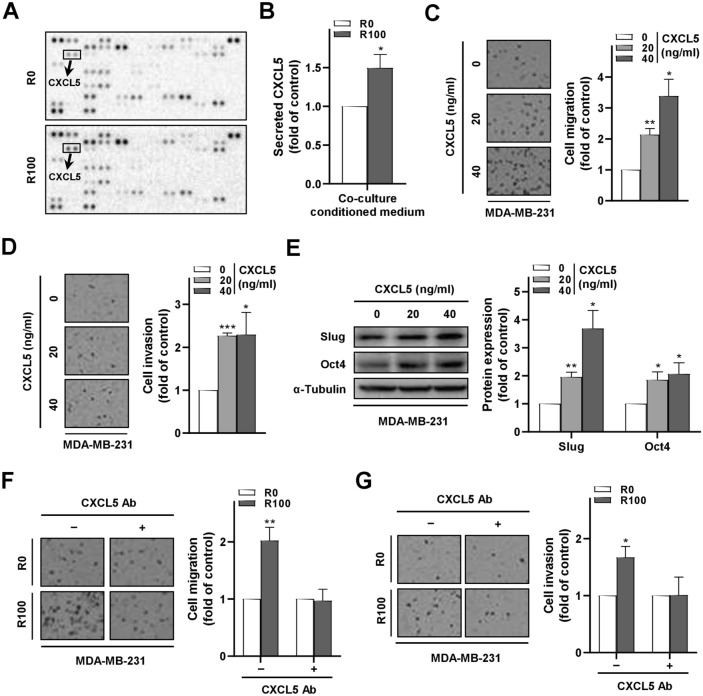Figure 3.
Secreted CXCL5 in the conditioned medium of the co-culture model with resistin-stimulated ADSCs promoted malignant behaviors of breast cancer cells. The isolated ADSCs were treated with resistin at 0 and 100 ng/ml (R0 and R100, respectively) for 48 h, followed by co-culture with MDA-MB-231 cells in the transwell model for another 72 h before the analyses in (A,B,F,G). (A) The conditioned medium from the co-culture of R-ADSCs (R100) or control ADSCs (R0) with MDA-MB-231 cells was collected and analyzed by cytokine/chemokine proteome array. A total of 102 proteins were detected with duplicates for each protein. The position of CXCL5 on the array was highlighted. (B) Secreted protein level of CXCL5 in the conditioned medium from the co-culture of R-ADSCs (R100) or control ADSCs (R0) with MDA-MB-231 cells was analyzed by ELISA. (C) MDA-MB-231 cells treated with recombinant CXCL5 (0, 20, and 40 ng/ml) for 48 h were collected and evaluated by cell migration assay. (D) MDA-MB-231 cells treated with recombinant CXCL5 (0, 20, and 40 ng/ml) for 48 h were collected and evaluated by cell invasion assay. (E) MDA-MB-231 cells treated with recombinant CXCL5 (0, 20, and 40 ng/ml) for 48 h were collected and analyzed for the protein expression of mesenchymal marker Slug and cancer stemness marker Oct4 by Western blot. The original blot images in (A) and (E) were available in Supplementary Information. (F,G) CXCL5 neutralizing antibody was added ( +) or omitted (–) during the co-culture of R-ADSCs (R100) or control ADSCs (R0) with MDA-MB-231 cells. After the co-culture, MDA-MB-231 cells were collected and evaluated by cell migration assay in (F) and cell invasion assay in (G). Data were obtained from three independent experiments and presented as mean ± SEM. Statistical difference was determined by t-test comparing R100 group versus their corresponding R0 group as control, or comparing recombinant CXCL5 treatment group (20 and 40 ng/ml) versus recombinant CXCL5 control group (0 ng/ml). *p < 0.05; **p < 0.01; ***p < 0.001.

